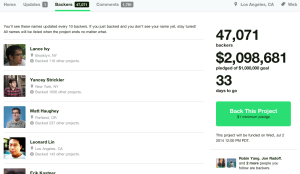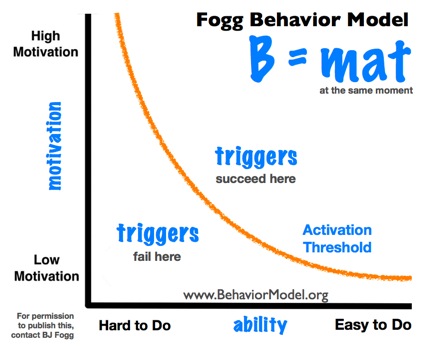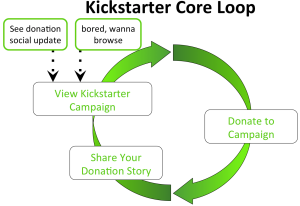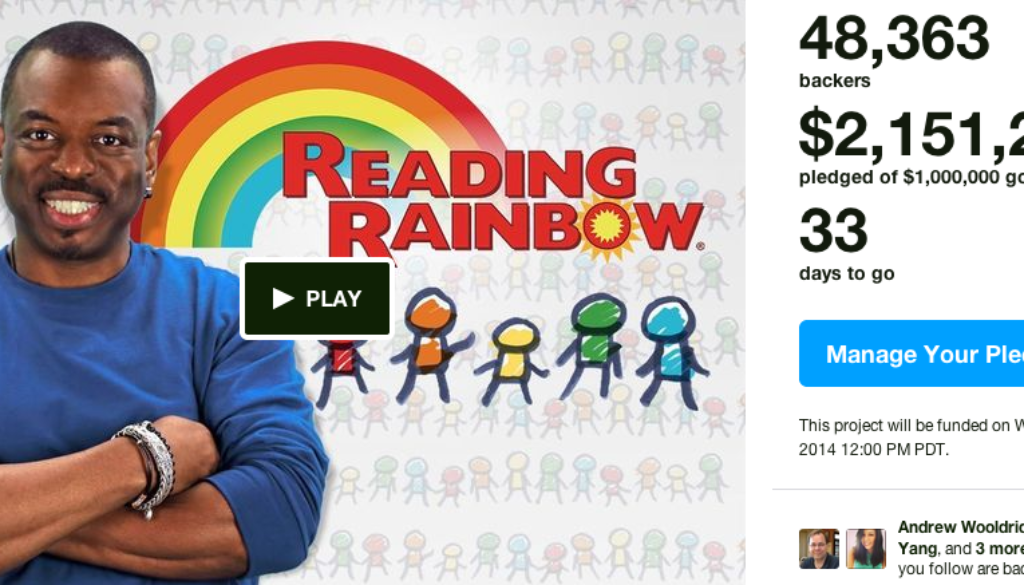Triggers and Investment Pull Players Back
Have you seen LaVar Burton’s Reading Rainbow Kickstarter? It’s a living MasterClass in effective crowdfunding design. This campaign has it all:
- a big bold vision paired with the warm nostalgic appeal of a beloved brand
- a well-written, persuasive, emotionally compelling video
- clear, punchy writing and visuals
- an easy-to-digest info-graphic summarizing the core message
- an irresistible mix of do-good cause plus celebrity-tinged you-deserve-it reward tiers
I stumbled onto the campaign during my daily Twitter “watercooler break.” This update piqued my interest:

This one moved me to click through and check out the campaign.

After I watched the video, read the campaign description and checked out the backer page for social proof, I felt good about contributing.

So I donated – joining the pop-up club of Reading Rainbow fans who love the show and want to see it re-ignited.

When prompted, I was happy to share my newfound sense of belonging and love for “the cause.” Inspired by the tweets that pulled me in, I replaced the default text with a personal message about why I contributed.

Now the loop is complete. It started when I responded to a social trigger – moved through emotional engagement and financial investment – and ended when I created a social trigger for others.
That, my friends, is a tight, effective core loop in action.
Triggers and Investment Pull Players Back
Activities, feedback and progress can engage your players – but triggers and investment will complete the loop and pull them back. Let’s dig into how these interlocking concepts work.
Triggers are internal or external events that remind you to DO something. Triggers come in several flavors:.
- Internal Triggers are feelings, urges or cravings for some activity – eating, stretching, running, watching a video, checking the weather, grabbing a drink, playing a game, etc.
- External Triggers are environmental cues – alerts, notifications, shoes by the door, post-it’s on the mirror – that remind yourself to do some activity
- Social Triggers are messages, meetups, opportunities, or obligations involving other people that motivate your behavior
Suppose you want to exercise more. You might:
- leave your running shoes by the door (external trigger)
- setup reminders to run using an exercise app (external trigger)
- feel an urge to crank up some endorphins after an intense meeting (internal trigger)
- say YES to a walking meeting invitation (social trigger)
Internal AKA emotional triggers are the post powerful type of trigger, because they translate into internal motivation. External triggers provide important scaffolding that supports internal motivation – but alone, they’re not sufficient to motivate behavior. As B.J. Fogg describes in his ground-breaking Fogg Behavior Model, behavior change comes about when external triggers, personal ability and internal motivation all line up.

Now let’s take a look at investment – that feeling elicited by collecting, earning customizing, or building something you don’t want to lose. Anytime you create an avatar, refine your profile, check your stats, earn redeemable points, integrate your address book, or curate your friend list, you’re deepening your investment in that system – and making it harder to leave.
Continuing the example above, how might investment impact your desire to exercise more?
- Personal Goals: once you articulate a goal, you’re making it concrete and real – and setting up an implicit challenge to attain that goal. That type of investment is on display in Lift – a habit-building app that helps you setup and track small, achievable goals – similar to B.J. Fogg’s Tiny Habits program.
- Improving Skill: one powerful form of investment is self-improvement. It’s inherently motivating to see yourself getting better, stronger, faster, smarter. That’s why so many systems tune their tracking algorithms to show visible progress – it’s what gets people hooked and keeps them coming back. The Couch-to-5K running program is a great example of investment through skill-building, attainable goals, and visible progress.
- Personalize Identity: anytime you customize your identity or environment, you’re investing a bit of yourself into the system. That’s why buying new running shoes or gear, you’re enhancing your self-image as a runner – and investing $$ into the habit. That’s also why something as simple as choosing colors and selecting your background image increases your investment through personal expression.
- Involve Your Friends: some people thrive on social motivation and engagement. If you’re that type of person, you’l feel more invested in your exercise program if you can share your fitness activities and goals with your friends. The exercise app Endomondo, for example, offers an easy way to build your friend network and share your workouts.

The most effective triggers are tied to your investment in the system. Kickstarter’s Core Loop (shown below) beautifully showcases this relationship. People are primed to share (AKA create a trigger) right after contributing (AKA investing time & $$). A contributor’s personal, heartfelt message about the campaign creates a social trigger that’s far more powerful than any marketing copy.

As you’re designing your Core Loop, ask yourself these questions:
- What type of investment are players making in the system?
- How is that investment expressed in the core systems and UX?
- What emotional, personal and/or social triggers remind players to return?
- What’s the emotional “hit” they’re being trained to crave?
- What existing (or wished-for) social relationships motivate their behavior?
Finding the right triggers, hooks and investment systems will dramatically increase your ability to turn your experience into a habit.
